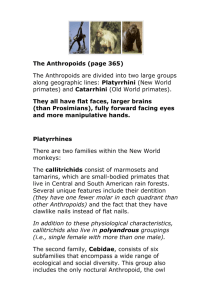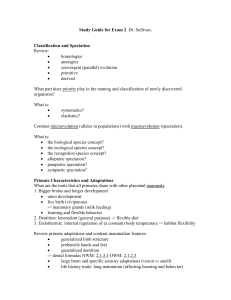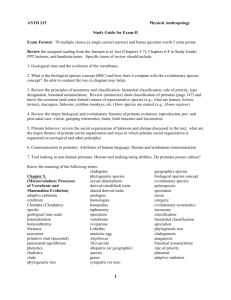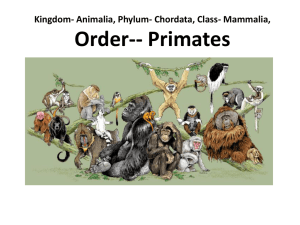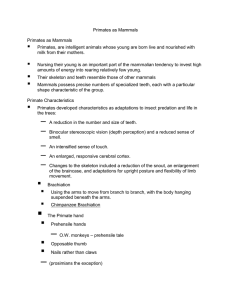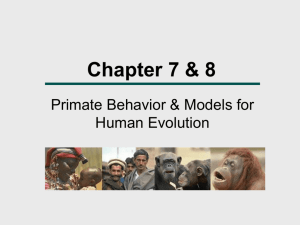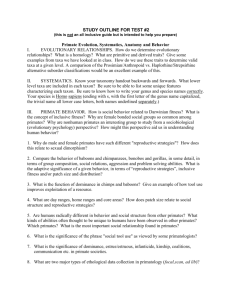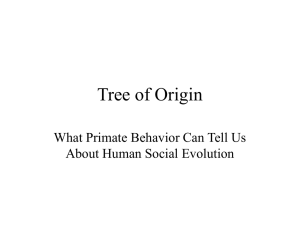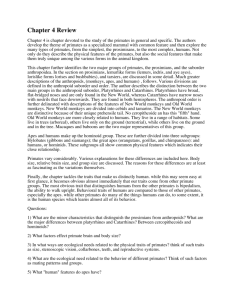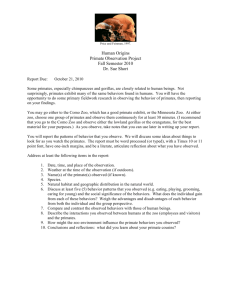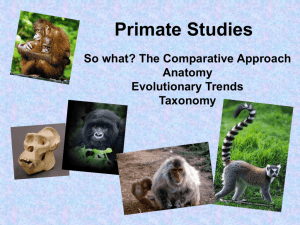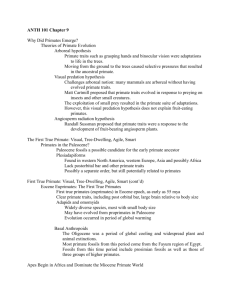Primates Test - phsgirard.org
advertisement
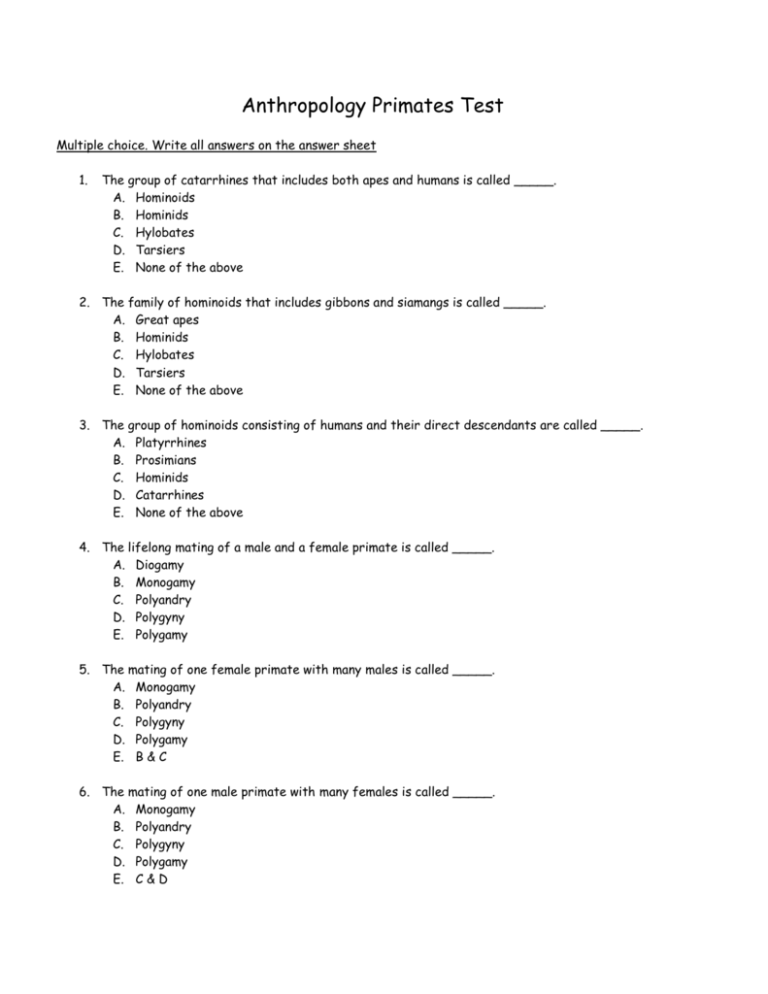
Anthropology Primates Test Multiple choice. Write all answers on the answer sheet 1. The group of catarrhines that includes both apes and humans is called _____. A. Hominoids B. Hominids C. Hylobates D. Tarsiers E. None of the above 2. The family of hominoids that includes gibbons and siamangs is called _____. A. Great apes B. Hominids C. Hylobates D. Tarsiers E. None of the above 3. The group of hominoids consisting of humans and their direct descendants are called _____. A. Platyrrhines B. Prosimians C. Hominids D. Catarrhines E. None of the above 4. The lifelong mating of a male and a female primate is called _____. A. Diogamy B. Monogamy C. Polyandry D. Polygyny E. Polygamy 5. The mating of one female primate with many males is called _____. A. Monogamy B. Polyandry C. Polygyny D. Polygamy E. B & C 6. The mating of one male primate with many females is called _____. A. Monogamy B. Polyandry C. Polygyny D. Polygamy E. C & D 7. The Hominoids whose members include both the living and extinct apes is called _____. A. A. Platyrrhines B. Catarrhines C. Parapithecids D. Pongids E. B & C 8. The trophic level of most primates is _____. A. Carnivores B. Herbivores C. Omnivores D. Insectivores E. None of the above 9. The _____ suborder includes humans, apes, and monkeys. A. Anthropoid B. Cercopithecoid C. Haplorhine D. Prosimian E. Strepsirhine 10. Primate arboreal locomotion is primarily _____. A. Bipedal B. Brachiating C. Vertical clinging and leaping D. B & C E. A & B Fill in the blank. Use the appropriate vocabulary to complete each statement. 11. An organism that is active during the day is 12. An organism that is active during the night is 13. A heterotroph that eats only plants is called 14. A heterotroph that eats only meat is called 15. A primate hand or tail which grasps is called 16. The study of primates is 17. A thumb that can touch the tips of all the other fingers is said to be 18. This type of primate locomotion occurs when the weight of the upper part of the body is supported on the thickly padded knuckles of the hands 19. A marked difference in size and appearance between males and females of a species is called 20. The length of time a young primate is dependent on an adult is called 21. The center of speech and other higher mental activities is called 22. Callouses on the bottoms of Cercopithecine monkeys are called 23. Primates have two eyes facing forward which gives them this type of vision 24. The locomotion of a primate that walks on all four limbs is called 25. Pre-monkeys are called Matching. Place the letter that matches the description in the blank on the answer sheet. A. B. C. D. E. F. G. H. I. J. K. L. M. N. Cebids Cercopithecines Chimpanzees Colobines Gibbons Gorillas Lemurs, Indris, Aye-ayes Lorises, bushbabies Marmosets Miocene apes Orangutans Siamangs Tamarins Tarsiers 26. Gigantopithecus is an example 27. The only nocturnal primate found on the islands of the Philippines and Indonesia that are carnivores 28. The dominant male silverback _____ has a harem with many females 29. Indigenous to Madagascar; Family: Lemuridae 30. New world monkey with thumbs that cannot grip against the fingers 31. From the genus Pan; Uses tools such as leaves for personal hygiene or drinking water 32. Family : Galagonidae 33. Old world monkey, Species: mitis or hamlyni 34. Owl faced or Blue monkey, Family: Cerpithecinae 35. Name means a grotesque figure or ugly little boy 36. Family: Hylobatidae 37. Found only on the islands of Borneo and Sumatra and the heaviest arboreal primates 38. Mother Primates which allow other group members to care for infants shortly after birth 39. Family: Tarsioidae 40. Name means “Dwells in trees” and live in Malaysia, Indonesia, and Sumatra 41. New world monkeys from the genera: Callithrix and Cebuella 42. Have glands on feet for marking territory; Family: Indriidae 43. Genus: Nycticebus; tend to be vertical leapers 44. Have ability to learn sign language 45. New world monkeys which are preyed on by ocelots and jaguars; communicate by urinating on themselves and rubbing a tree 46. Average adult male eats 50 lbs of food per day; have unique nose prints 47. Lived 24 million to 5.2 million years ago, now extinct 48. Have claws instead of fingernails 49. Largest of the extant (Still living) apes 50. Actively hunt other larger animals Anthropology Primates Test Answer Sheet 1. _____ 26. _____ 2. _____ 27. _____ 3. _____ 28. _____ 4. _____ 29. _____ 5. _____ 30. _____ 6. _____ 31. _____ 7. _____ 32. _____ 8. _____ 33. _____ 9. _____ 34. _____ 10. _____ 35. _____ 11. ______________________________ 36. _____ 12. ______________________________ 37. _____ 13. ______________________________ 38. _____ 14. ______________________________ 39. _____ 15. ______________________________ 40. _____ 16. ______________________________ 41. _____ 17. ______________________________ 42. _____ 18. ______________________________ 43. _____ 19. ______________________________ 44. _____ 20. ______________________________ 45. _____ 21. ______________________________ 46. _____ 22. ______________________________ 47. _____ 23. ______________________________ 48. _____ 24. ______________________________ 49. _____ 25. ______________________________ 50. _____
